The House of Rothschild (115 page)
Read The House of Rothschild Online
Authors: Niall Ferguson

In 1836, following the death of Nathan Mayer Rothschild, his brothers, sons and nephew bound themselves together in a new partnership agreement. In doing so, they recalled how their father Mayer Amschel had told them nearly thirty years before “that acting in unison would be a sure means of achieving success in their work”; how he had “always recommended fraternal concord to them as a source of divine blessing.” It was a principle they exhorted future generations of the family to remember:
May our children and descendants in the future be guided by the same aim, so that with the constant maintenance of unity the House of Rothschild may blossom and grow into full ripeness ... and may they remain as mindful as we of the hallowed precept of our noble ancestor and present to posterity the godly image of united love and work.
It is remarkable that, two centuries after Nathan first arrived in England, those words should still have a meaningful resonance.
APPENDIX 1
Exchange Rates
Fortunately for the economic historian, the nineteenth century was characterised by a protracted process of currency convergence. After the pound returned to its pre- 1797 Newtonian gold parity in the 1820s, other major currencies one by one established more or less stable exchange rates with it. It should be stressed that the gold standard proper was a late-nineteenth-century affair. Until the 1870s, France remained on a bimetallic (gold and silver) standard, along with the other members of the Latin Monetary Union (Belgium, Switzerland and Italy). Russia, Greece, Spain and Rumania were also bimetallist, as were most American states including the US. Most German states were on pure silver standards, as were the Scandinavian counties, Holland and most of Asia. Only Britain, Portugal, Canada, Australia and Chile were strictly speaking on the gold standard in 1868. However, despite these differences, European exchange rates were relatively stable. The French, Belgian and Swiss francs were more or less consistently equivalent to one-twenty-fifth of a pound (that is, £1 = c. 25 francs: in fact, the franc-sterling exchange rate fluctuated between around 25.16 and 25.40 francs). The Prussian thaler was equally stable at around 6.8 thalers to the pound. The Austrian, Italian, Russian, Greek and Spanish currencies were not so stable, however, and were subject to periods of inconvertibility and depreciation. Table a gives some approximate sterling exhange rates for major European currencies at mid-century, though these should be used with some caution.
Table a: Sterling exchange rates of major currencies (per pound), mid-nineteenth century.

Source: Rothschild correspondence.
The process of German unification was decisive in the shift from bi-metallism to the gold standard. The German decision to establish a gold-based mark rather than extending the silver thaler to the rest of the German Reich had a knock-on effect in France, which was reluctant for political reasons to smooth the German transition to gold by continuing to accept silver. Even so, until the very end of the century, a number of major currencies were not consistently on a metallic standard and were subject to periods of depreciation against sterling (this applies to the rouble and the dollar). It was not until the last two decades before the First World War that most of the world’s economies were members of the informally constituted system of fixed exchange rates known as the gold standard; only China, Persia and a few Latin American economies remained on silver. Table b gives the pre-1914 parities once most currencies had joined (strictly speaking, the currencies of Italy and Austria were not legally convertible into gold, but their exchange rates were relatively stable nonetheless).
Table b: Sterline exchange rates of major currencies (per pound), 1913.

Source: Hardach,
First World War
, p. 293.
First World War
, p. 293.
APPENDIX 2
Selected Financial Statistics
A private partnership of the sort formed by the five Rothschild houses was under no obligation in the period covered by these statistics to produce balance sheets or profit and loss accounts. The figures for the capital of the five houses produced in tables c and d are taken from the surviving partnership agreements. The profit and loss accounts for N. M. Rothschild & Sons are based on summaries (the purpose of which is not known) which begin in 1829. The accounts are simple: on one side all the year’s sales of commodities, stocks and shares are listed, on the other, all the year’s purchases and other costs; the difference is recorded as the annual profit or loss. Table e gives the “bottom line” data and also figures for net appropriations (withdrawals and new capital) by partners. The balance sheet figures in table
f
are based on a similar series of summaries dating from 1873.
f
are based on a similar series of summaries dating from 1873.
Nineteenth-century banks did not draw up balance sheets or profit and loss accounts in a standardised way, so comparisons with other banks for which figures are available must be made with extreme caution.
Table c: Combined Rothschild capital, 1818-1904 (selected years, £ thousand).
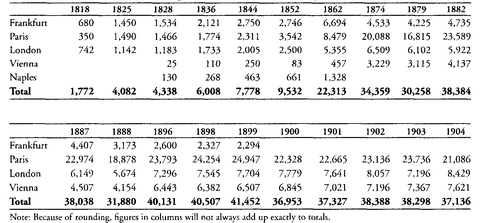
Sources: CPHDCM, 637/1/3/1-11; 1/6/5; 1/6/7/7-14; 1/6/32; 1/6/44-5; 1/7/48-69; 1/7/115-20; 1/2/1-7; 1/9/1-4; RAL, RFamFD/3, B/1; AN. 132 AQ 1, 2, 3, 4, 5, 6, 7, 9, 10, 13, 15, 16, 17, 19; Gille,
Maison Rothschild,
vol. II, pp. 568-72.
Maison Rothschild,
vol. II, pp. 568-72.
Table d: Rothschild partners’ shares of capital, 1852-1905 (percentages).
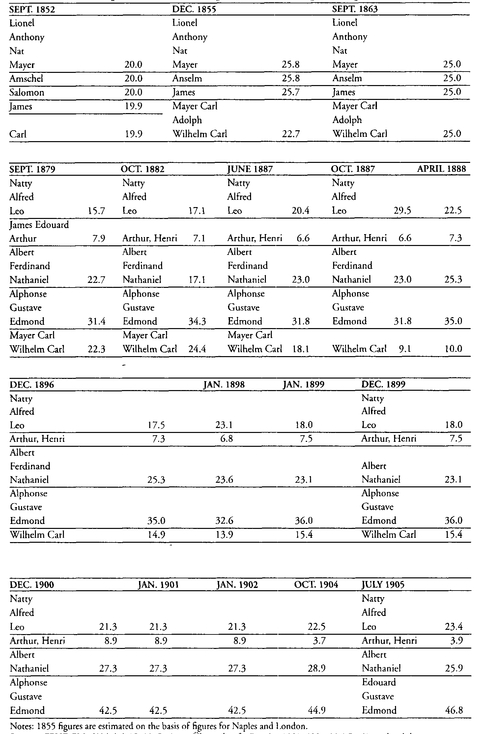
Sources: CPHDCM. 637/1/7/115-20, Societats-Übereinkunft, Oct. 31, 1852; AN, 132 AQ 3/1, undated document, c. Dec. 1855; AN, 132 AQ 2, Partnership act, no. 2, Sept. 1879; Oct. 24, 1882; June 28, 1887; April 2, 1888; Nov. 23, 1899; Dec. 24, 1900; Dec. 16, 1901; Nov. 27, 1902; July 24, 1903; Gille,
Maison Rothschild,
vol. II, pp. 568—72.
Maison Rothschild,
vol. II, pp. 568—72.
Table e: N. M. Rothschild & Sons: profit and loss accounts, 1849-1918 (£).
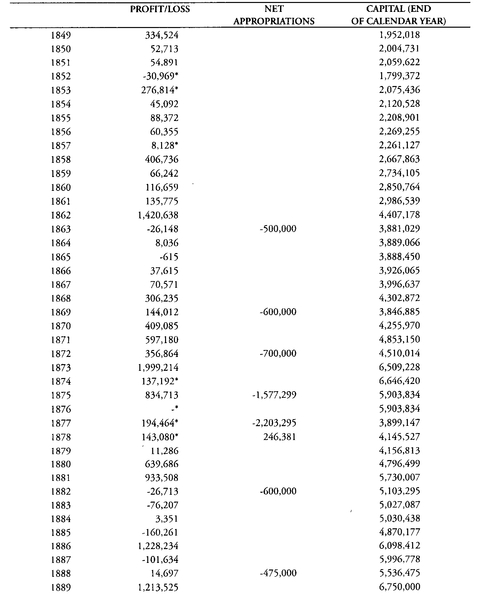
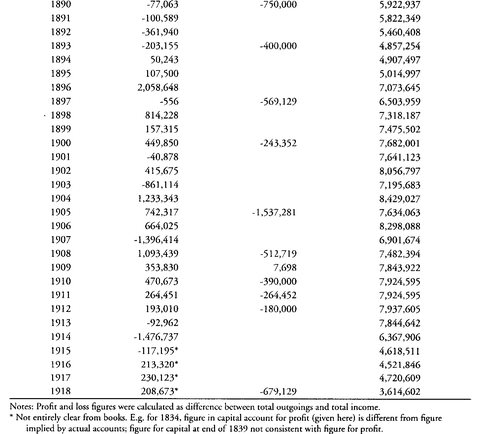
Sources: RAL, RFamFD/13F; RFamFD/13E.
Table f: N. M. Rothschild & Sons: balance sheets, 1873-1918 (£, end of calendar year).
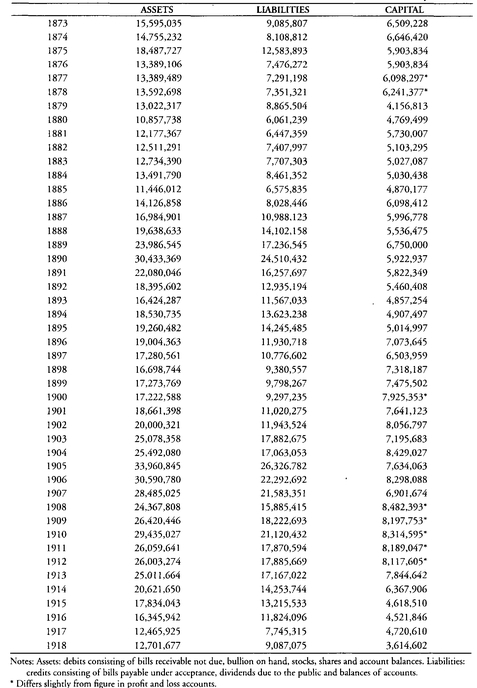
Sources: RAL, RFamFD/13a/1; 13B/1; 13C/1; 13D/1; 13D/2; 13/E.
NOTES
The endnotes have been substantially reduced in number for the paperback edition. Scholars seeking detailed references should consult the hardback, which also contains a complete bibliography.
ONECharlotte’s
Dream
(1849-1858)
1
According to Greville, Gutle frequently went on such excursions and went “constantly to the opera or play.” She was clearly not as ascetic as Borne and others liked to think.
According to Greville, Gutle frequently went on such excursions and went “constantly to the opera or play.” She was clearly not as ascetic as Borne and others liked to think.
2
Amschel subsequently offered to lease him the house in the Bockenheimer Landstrasse, though Bismarck declined, rightly detecting in Amschel’s overtures an attempt to curry favour. According to that other arch-reactionary the King of Hanover, Amschel did this sort of thing “whenever any foreign Prince or Minister or man of distinction comes to Frankfurt.” At his dinners there was “great grandeur and sumptuousness as to show of plate and luxuries, but he amuses the company by telling them where he bought his fish and meat, and the immense sums he has sacrificed on the occasion ... shewing every moment le parvenu and the narrow minded lender and discounter of bills of exchange.”
Amschel subsequently offered to lease him the house in the Bockenheimer Landstrasse, though Bismarck declined, rightly detecting in Amschel’s overtures an attempt to curry favour. According to that other arch-reactionary the King of Hanover, Amschel did this sort of thing “whenever any foreign Prince or Minister or man of distinction comes to Frankfurt.” At his dinners there was “great grandeur and sumptuousness as to show of plate and luxuries, but he amuses the company by telling them where he bought his fish and meat, and the immense sums he has sacrificed on the occasion ... shewing every moment le parvenu and the narrow minded lender and discounter of bills of exchange.”
Other books
The Lost Girls of Johnson's Bayou by Jana DeLeon
The Millionaire Makeover (Bachelor Auction) by Naima Simone
What We Talk About When We Talk About Anne Frank: Stories by Nathan Englander
Magic in the Shadows by Devon Monk
Theirs by Jenika Snow
Snatched by Unknown
Grunts by Mary Gentle
Danger at the Fair by Peg Kehret
The Last Chamber by Dempsey, Ernest
Beware of the Trains by Edmund Crispin